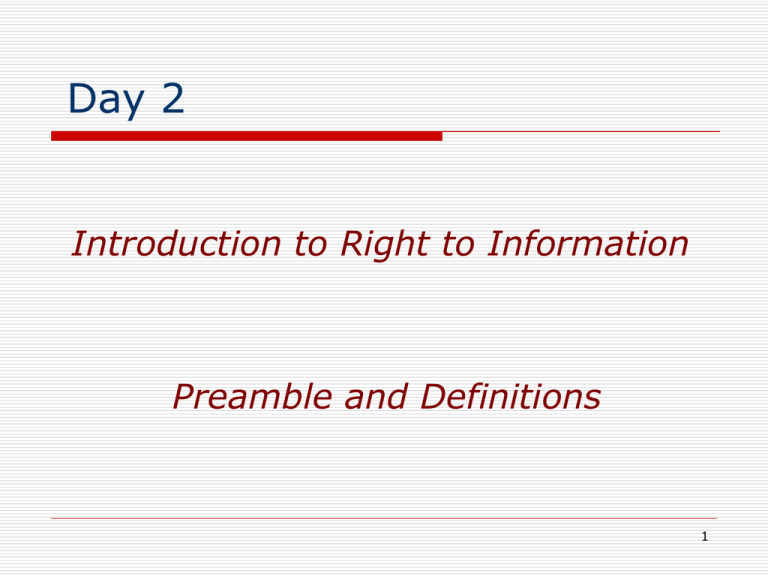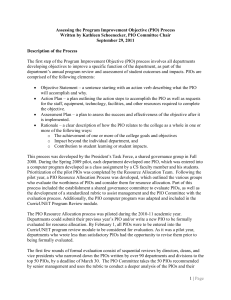Contd. - RTI OCC
advertisement

Day 2 Introduction to Right to Information Preamble and Definitions 1 Presentation Scheme List of Abbreviations / Acronyms The Preamble Salient Features of the ‘RTI Act, 2005’ Some Key Concepts / Definitions in the ‘RTI Act, 2005’ References 2 List of Abbreviations / Acronyms APIO(s) Assistant Public Information Oficer(s) IC(s) Information Commission(s) NGO(s) Non Government Organisation(s) PIO(s) Public Information Officers RTI Right to Information Ss Section(s) PAs Public Authorities AG Appropriate Government CA Competent Authority FAA First Appellate Authority United Nations Development Program GOI Government of India UNDP 3 Official Citation... THE RIGHT TO INFORMATION ACT, 2005 (short title) No. 22 of 2005 Note: This Act extends to the whole of India except the State of Jammu and Kashmir. 4 The Preamble… An Act to provide for setting out the practical regime of right to information for citizens to secure access to information under the control of public authorities, in order to promote transparency and accountability in the working of every public authority, the constitution of a Central Information Commission and State Information Commissions and for matters connected therewith or incidental thereto. 5 The Preamble… The Preamble explains the rationale and the objectives for enacting the ‘RTI Act, 2005 thus: WHEREAS the Constitution of India has established democratic Republic; AND WHEREAS democracy requires an informed citizenry and transparency of information which are vital to its functioning and also to contain corruption and to hold Governments and their instrumentalities accountable to the governed; 6 The Preamble………………………………………………………II AND WHEREAS revelation of information in actual practice is likely to conflict with other public interests including efficient operations of the Governments optimum use of limited fiscal resources and the preservation of confidentiality of sensitive information; AND WHEREAS it is necessary to harmonise these conflicting interests while preserving the paramountcy of the democratic ideal; Contd. 7 The Preamble…………………………………………………….III NOW, THEREFORE it is expedient to provide for furnishing certain information to citizens who desire to have it. BE it enacted by Parliament in the Fifty-sixth Year of the Republic of India as follows:(CHAPTER I of the ‘RTI Act, 2005’ immediately follows) Contd. 8 Salient Features of the ‘RTI Act, 2005’… The Salient features of the Act are: Access to Information Duty to Furnish information Suo Motu and web based disclosures Limited exemptions. Overriding effect Contd. 9 Salient Features of the ‘RTI Act, 2005’………………….…………………II Exemptions - Specific class and prejudice based, Qualified and time limited. Covers Private Body and Third Party Information. Penalty for non – compliance Independent and Non-judicial appellate mechanism. Empowerment of citizens The provisions of the Act are over-riding in character. 10 Paradigm Shift BEFORE 1 2 3 4 AFTER Flow of Information Outwards (Citizen) Inwards (Superiors) From Information To accountability and Beyond Legal Entitlement Tool to fight corruption & Arbitrary use of Power Arbitrariness Ethical and participatory democracy Contd. 11 Paradigm Shift Records Management Setting Performance standards (Optional) Compulsory Storage Driven Retrieval driven Contd. 12 Definitions – Right to Information Section 2(j) right to information means the right to access information held by or under the control of any Public Authority It includes the right to: (i) inspection of work, documents or records (ii) taking notes, extracts or certified copies of documents or records (iii) taking certified samples of material (iv) obtaining information – stored in a computer or in any other device – in the form of diskettes, floppies, tapes, video cassettes or in any form electronic mode or through print outs. Contd. 13 Definitions - Information Section 2 (f) information means any material in any form and includes: records opinions orders papers documents advices logbooks samples memos press releases contracts models e-mails circulars reports data material held in any electronic form information relating to any private body which can be accessed by a PA under any other law for the time being in force Contd. 14 Definitions - Record Section 2(i) Record includes: any document, manuscript and file any microfilm, microfiche, and facsimile copy of a document any reproduction of images or images embodied in such microfilm (whether enlarged or not) Any other material produced by a computer or any other device. Note:’Record’ is included in the definition of ‘information’. Contd. 15 Definition - Appropriate Government Section 2(a) The Act defines an Appropriate Government (AG) in relation to a Public Authority (PA). PA: AG: established, constituted owned controlled or substantially financed by funds provided directly or indirectly by the Central Government or the Union territory administration Central Government established, constituted owned controlled or substantially financed by funds provided directly or indirectly by the State Government State Government Contd. 16 Definition - Competent Authority Section 2 (e) Competent Authority (CA) means: 1. Lok Sabha /Legislative Assembly > 2. Rajya Sabha/Legislative Council > 3. Supreme Court > 4. High Court > 5. For Constitutional bodies > 6. isFor Union by Territories CA required the ‘RTI >Act, 2005’ to make rules for implementing its provisions. Speaker Chairman Chief Justice of India Chief Justice of High Court President or Governor as the case may be Administrator appointed under Article 239 of the Constitution A PIO can disclose information exempt under Section 8(1), (d) & (e) if competent authority is satisfied that there is public interest in its disclosure 17 Definition - Public Authority Section 2(h) Any authority / body / institution of self-government established or constituted by: or under the Constitution (of India) any other law made by Parliament any other law made by State Legislature notification issued or order made by the appropriate government Any – body owned, controlled or substantially financed; non-Government organisation substantially financed, directly or indirectly by funds provided by the Appropriate Government (AG) Contd. 18 Definition- Public Information Officer (PIO) A PIO is an officer designated by the Public Authority: in any of its administrative units to provide information to persons requesting for information under the Right to Information Act, 2005 An APIO (Assistant PIO) is designated at each sub-divisional level or other sub-district level, to receive the applications for information or appeals, for forwarding the same to the PIO. Note: The Act does not prescribe any number or levels for designating PIOs. It has been left to a PA’s judgment to determine an adequate number. Accordingly, PAs have designated more than one PIO – sometimes by even designating PIOs for particular function(s) of the PA. 19 Definition - First Appellate Authority (FAA) An officer senior in rank to PIOs in each PA to receive appeals against the decision of a PIO: preferred by the requesters – within 30 days from the receipt of the decision or within 30 days from the expiry of period specified in S. 7(1) or S. 7(3)(a), if no such decision was communicated. [S. 19(1)] preferred by third parties as per S. 11(4) – within 30 days from the date of the order as per S. 11(3). No discretion for accepting appeals after 30 days is available to the FAA in this case. [S. 19(2)] 20 Summary: Who Receives Applications / First Appeals… Who? What? Level First Appellate Authority Only hears first appeals Public Information Officer Receives applications and provides information Only receives applications Officer, senior in rank to the Public Information Officer In all administrative units or offices Assistant Public Information Officer At every subdivisional or other sub-district level 21 Definitions- Third Party and Prescribed Section 2(n) third party means a person other than the citizen making a request for information and includes a PA Section 2(g) prescribed a term used at several places in the Act –means prescribed by rules made under this Act by the appropriate government or the competent authority as the case may be Contd. 22 References ‘Right to Information Act’, 2005 – Bare Act. A soft copy is available on this website. It is downloadable. Note: The bare Act will be a key reference for this and all the later chapters of this course. Downloadable soft copies of the Act are also available on www.rti.gov.in (RTI Portal), www.cic.gov.in (Website of the Central Information Commission), To access these other links, please copy and paste the link(s) in a new browser window. Do not close the existing window. These and other related resources may also be accessed from the websites of The various State Information Commissions (where available). Links to the State IC websites are available on www.rti.gov.in Contd. 23 End of Day 2 You must take the Quiz for this Chapter before proceeding to the next Chapter! 24









